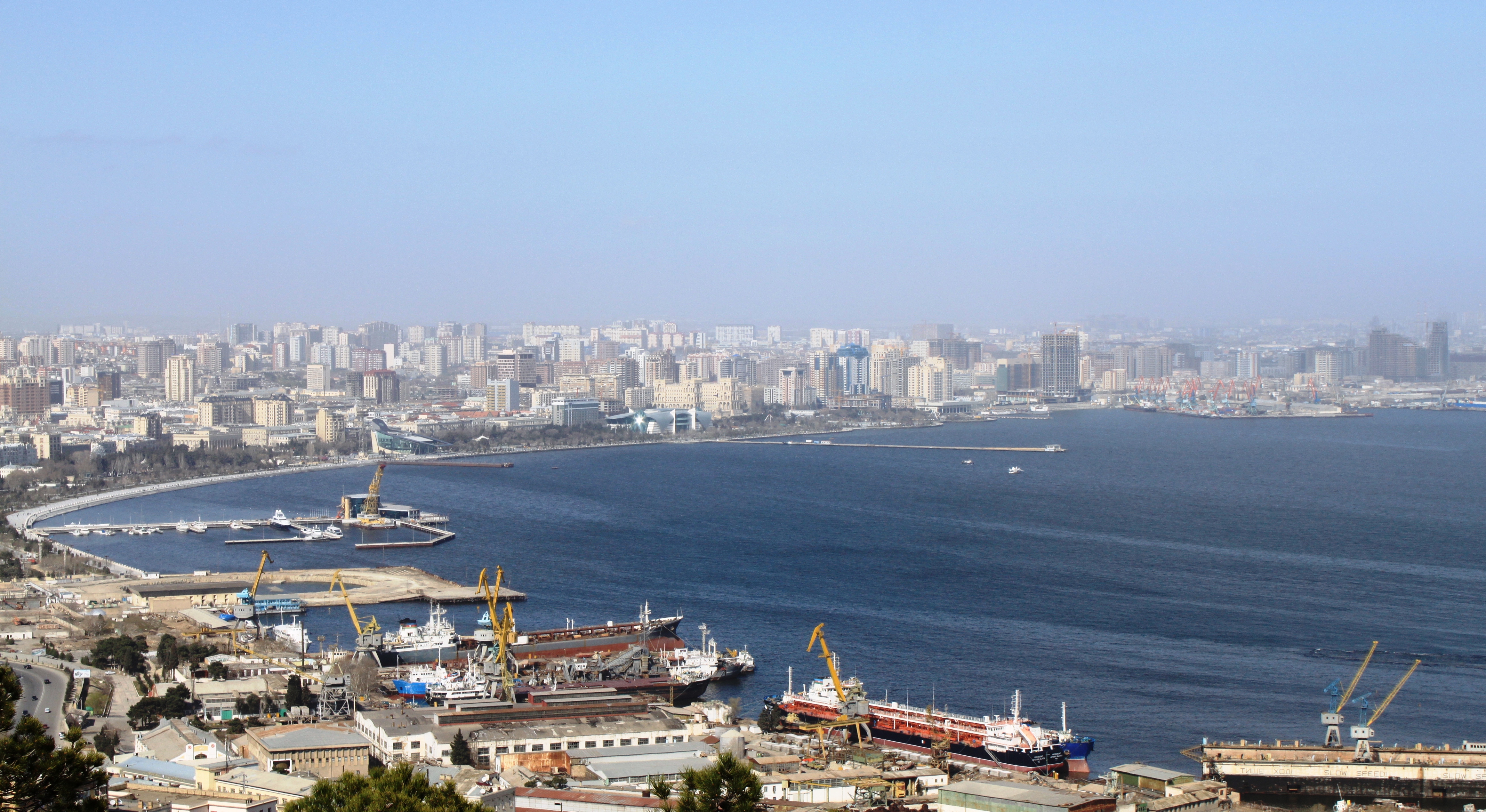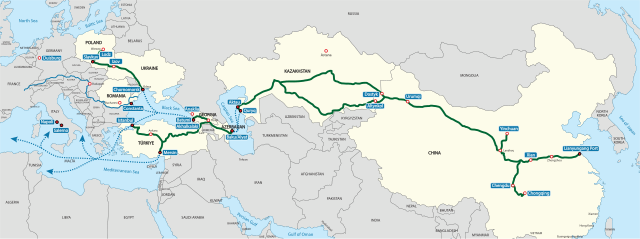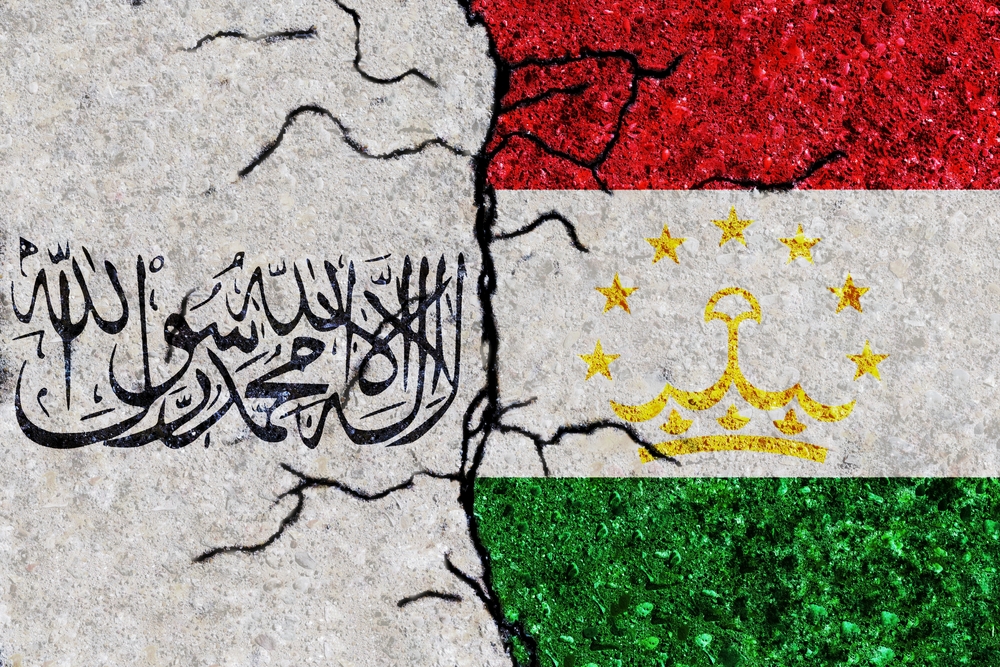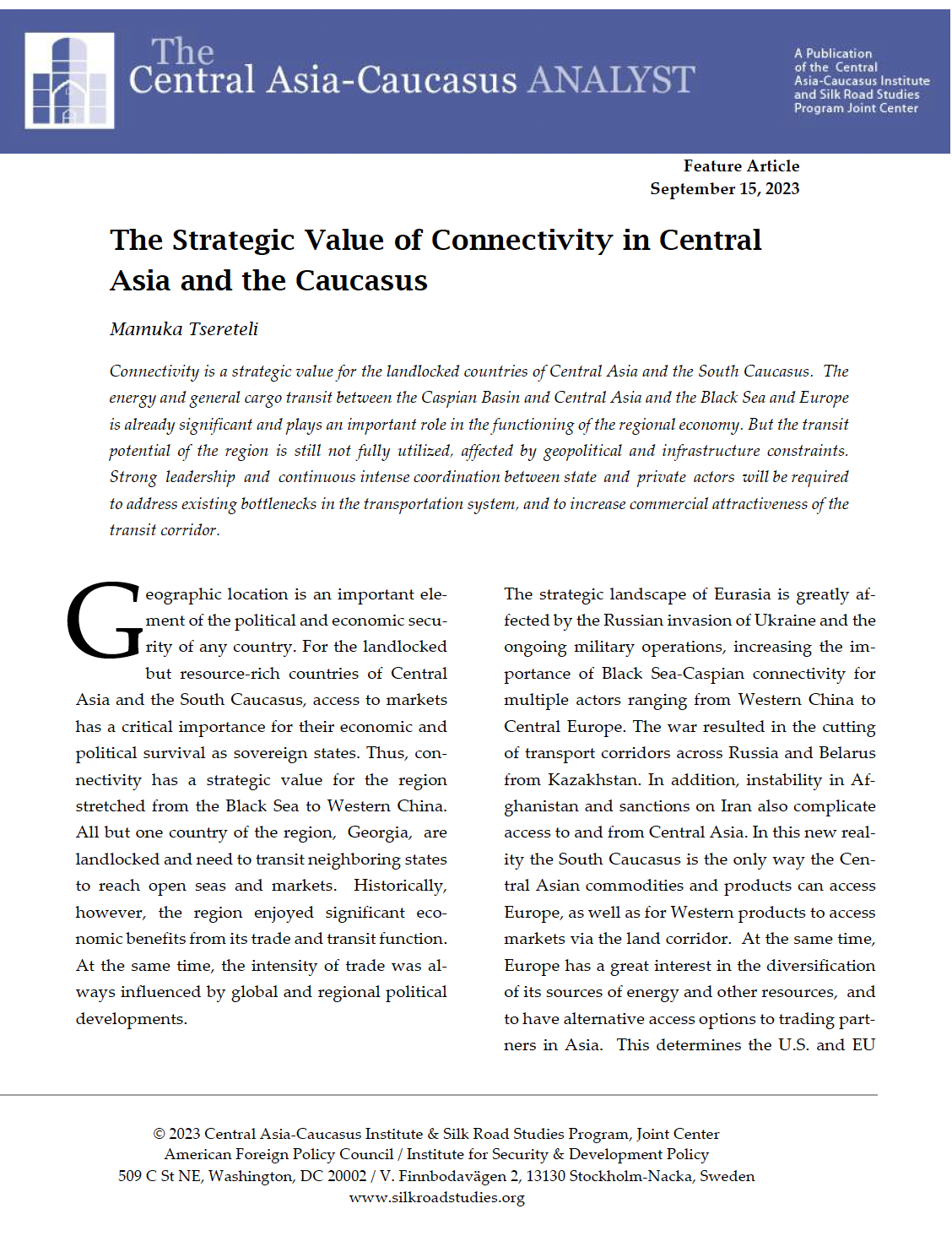Extending the Middle Corridor to Afghanistan: Implications for Uzbekistan
By Nargiza Umarova
Azerbaijan is strengthening its political and economic ties with the Taliban government by playing an active role in creating and developing promising transport routes to South Asia. At the forefront is the Lapis Lazuli Corridor, launched in 2018 through a joint initiative of Afghanistan, Azerbaijan, Turkey, Georgia and Turkmenistan, similar to the ancient route of the Great Silk Road. The possibility of extending the corridor to South Asia is being considered, which would have geo-economic and geopolitical implications for Uzbekistan.

Credit: Wikimedia Commons
BACKGROUND: The US$2 billion Lapis Lazuli Agreement was signed by Afghanistan, Azerbaijan, Georgia, Turkey and Turkmenistan on 15 November 2017. The route runs from the Afghan cities of Aqina in Faryab Province and Torghundi in Herat Province, through the Caspian Sea ports of Turkmenbashi and Baku, and the Georgian Black Sea ports of Poti or Batumi, to Istanbul or Kars in Turkey, with further access to the European transport system.
The first test shipment along the Lapis Lazuli logistics chain was carried out in 2018. In January 2021, Turkmenistan, Azerbaijan and Afghanistan signed a trilateral roadmap to develop this route. However, implementation of the document was suspended due to the Taliban's seizure of power in Kabul in August 2021.
Against the backdrop of pragmatic interactions between Central Asian states — particularly Uzbekistan — and the current Afghan leadership, Azerbaijan is also seeking to strengthen its position in Afghanistan as a partner in trade, the economy, transport, and logistics.
Baku’s main priority is the Middle Corridor project, a vital logistics link between China and Europe. The Lapis Lazuli Corridor essentially extends the Middle Corridor to Afghanistan. This enables Kabul to take part in trans-Caspian shipping and to redirect some of its export cargo bound for the European market from Pakistan or Iran, to the South Caucasus and Turkey.
In 2024, Afghanistan’s total trade with the EU was approximately US$ 42 million, which is 15.9 percent higher than the previous year’s figure. Experts predict that this growth trend will continue. Meanwhile, Azerbaijan is attempting to accelerate these processes by adopting a proactive approach to its relations with the Taliban.
On July 2, 2025, on the sidelines of the Economic Cooperation Organization summit in Khankendi, Azerbaijan, Abdul Ghani Baradar, Afghanistan’s Deputy Prime Minister for Economic Affairs, met with Azerbaijani Prime Minister Ali Asadov. They emphasized Baku’s readiness to increase export and import volumes with Afghanistan. The Afghan delegation visited the Baku International Seaport, where they discussed expanding the geography of freight transport along the South Asia-Caucasus-Europe route and integrating Afghanistan into the Middle Corridor.
Azerbaijan and Turkmenistan have made significant efforts to develop the infrastructure of the Lapis Lazuli Corridor. Azerbaijan has invested approximately US$ 1 billion in two vital elements of the project: the Alat Port in Baku and the Baku-Tbilisi-Kars railway. Meanwhile, Turkmenistan constructed the Atamurat (Kerki)-Ymamnazar-Aqina railway in 2016, and connected the Afghan cities of Aqina and Andkhoy by rail in 2021. The Caspian port of Turkmenbashi is also being modernized to increase its capacity. In order to generate economic returns on their investments and reap the long-term benefits of transport service exports, it is crucial for Baku, Ashgabat and other stakeholders along the route to maximize its utilization. This justifies the idea of extending the Lapis Lazuli Corridor to Pakistan and India, which would run contrary to Uzbekistan’s interests.
IMPLICATIONS: It is assumed that the transport corridor from Europe to India via the South Caucasus, Turkmenistan and Afghanistan will become an alternative to Tashkent’s strategic plan for connecting Eastern Europe with the Indian subcontinent. This plan involves linking the Trans-Afghan Railway (Kabul Corridor) with the Northern Railway Corridor through Russia. To this end, Uzbekistan has initiated the formation of the Belarus-Russia-Kazakhstan-Uzbekistan-Afghanistan-Pakistan-Indian Ocean ports transit route, which is set to launch in multimodal format soon.
The main benchmark for calculating the Kabul Corridor’s economic efficiency and feasibility is India’s growing potential for trade with Central Asian countries, the EU, China and Russia.
In the 2024 fiscal year, India’s trade turnover with the EU exceeded US$ 137 billion, with China US$ 118 billion, with Russia US$ 70 billion, and with Central Asian countries US$ 1.7 billion. The majority of Indian goods are delivered to promising markets by sea, which incurs high financial and time costs. The integration of India and Pakistan's transport space into the Eurasian road network is expected to stimulate land transportation along the South Asia-Europe axis. This shift holds great potential for the Kabul Corridor, with a projected annual cargo volume of up to 22 million tons, most of which will be in transit.
However, the extension of the Middle Corridor to Afghanistan and the development of further access to Pakistan and India will redistribute the flow of cargo from South Asian countries to Europe in favor of Turkmenistan and Azerbaijan, who are connected by the Caspian Sea. In turn, this risks diminishing Uzbekistan’s exclusive role as a trans-Eurasian transport link.
In theory, the Lapis Lazuli Corridor could be extended to Pakistan by constructing a railway line from Torghundi station on the Afghan-Turkmen border to Naibabad station, which marks the beginning of the Afghan section of the Kabul Corridor. Although this would exclude Uzbekistan from the India-EU supply chain, it would enable the Kabul Corridor to attract additional cargo from the South Caucasus and Turkmenistan. However, this advantage would not offset Uzbekistan’s loss of transit flows from the larger economic centers of Eurasia.
Connecting the Lapis Lazuli and Kabul corridors would motivate constructing the Herat-Mazar-i-Sharif railway, which would breathe new life into the long-standing Five Nations Railway Corridor project, running through China, Kyrgyzstan, Tajikistan, Afghanistan and Iran. The Five Nations Route bypasses Uzbekistan, significantly reducing the distance between East and West. This will probably diminish the importance of the Southern Railway Corridor, which runs through Central Asia, Iran, and Turkey, as well as the China-Kyrgyzstan-Uzbekistan railway, which is intended to be an important component of this route.
At the same time, constructing the Herat-Mazar-i-Sharif railway could undermine the Lapis Lazuli Corridor’s competitive advantage by increasing Iranian transit. Iran already has rail access to northern Afghanistan via the Khaf-Herat route, which is used to deliver Afghan cargo to Europe. Extending the Khaf-Herat railway to Naibabad station near Mazar-i-Sharif and connecting it to the Kabul Corridor would enable Iran to divert potential cargo traffic from India and Pakistan to Turkey and Europe via itself, thereby depriving Central Asian and South Caucasian countries of transit benefits. Consequently, there is a possibility that the Lapis Lazuli Corridor could be extended to South Asia, bypassing Kabul and instead passing through Kandahar. This would stimulate the development of the western Trans-Afghan Railway along the Torghundi-Herat-Kandahar-Spin Buldak route. Turkmenistan and Kazakhstan promote the project as an alternative to the Kabul Corridor.
Russia should be considered a potential stakeholder in the extension of the Lapis Lazuli Corridor along any of the trans-Afghan routes. Moscow has already announced plans to connect with Afghanistan via the Caspian Sea, utilising Turkmenistan’s port and rail infrastructure, which would integrate Russia into the Lapis Lazuli Corridor. This would establish a connection between India and Russia, and potentially Europe, through Turkmenistan and the Caspian port of Turkmenbashi, rather than through Uzbekistan.
CONCLUSIONS: Uzbekistan’s best option for maintaining and enhancing its competitive advantages in trans-Eurasian and trans-Afghan transport is to accelerate construction of the Kabul Corridor, involving all Central Asian states financially to the maximum extent possible. Kazakhstan’s practical support for developing the Kabul Corridor is important, as connecting it to the Northern Railway Route to Europe will enable Astana to receive an additional transit flow of up to 20 million tons per year. This will preempt any potential competition from Astana and Ashgabat in developing trans-Afghan transport connections.
It would be worth proposing to Baku the joint promotion of a new multimodal corridor from India, Pakistan, Afghanistan, Uzbekistan and Kazakhstan to Azerbaijan, Georgia, and the EU. This would stimulate the development of the Middle Corridor by increasing transport from South Asia and Afghanistan to Europe via the Caspian Sea.
Moreover, an alternative should be developed to the Five Nations Route, instead envisaging a connection between China, Afghanistan and Iran through Uzbekistan and neighboring countries. This would ensure the profitability of the Mazar-i-Sharif-Herat railway project for Tashkent.
AUTHOR'S BIO: Nargiza Umarova is a Senior Research Fellow at the Institute for Advanced International Studies (IAIS), University of World Economy and Diplomacy (UWED) and an analyst at the Non-governmental Research Institution ‘Knowledge Caravan’, Tashkent, Uzbekistan. Her research activities focus on developments in Central Asia, trends in regional integration and the influence of great powers on this process. She also explores Uzbekistan’s current policy on the creation and development of international transport corridors. She can be contacted at This email address is being protected from spambots. You need JavaScript enabled to view it. .
The Middle Corridor Remains Supplementary to Major Trade Routes between the EU and China
By Emil Avdaliani
Although the Middle Corridor, connecting the EU and China via the Black Sea and Central Asia, has witnessed notable development in recent years, its swift expansion is constrained by both geographical barriers and the political complexities prevalent along the route. The Northern Corridor through Russia would be further consolidated should Russia achieve a favorable resolution to its war in Ukraine. While the Middle Corridor serves as a dependable link between Central Asia and the EU, it is likely to remain a complementary route to the northern Eurasian commercial highway.

Photo source: Tanvir Anjum Adib
BACKGROUND: The Middle Corridor, also known as the Trans-Caspian Transport Corridor, extending from the Black Sea to Central Asia and western China, has gained prominence since 2022 following the onset of the war in Ukraine. Although the route had existed in practice since the 1990s and was formally inaugurated in the early 2000s, its scope remained limited due to inadequate infrastructure, geopolitical instability in the South Caucasus, and, more significantly, the appeal of the Russian route, which had facilitated trade between China and the EU. Compounding these challenges is the corridor’s multimodal nature—comprising both land and sea segments—which, despite making it the shortest geographical path between China and the EU, has ultimately rendered its operation economically unviable.
Indeed, data from the period prior to 2022 highlights this unfavorable reality: merely 2–3 percent of overland containerized freight traversed the Middle Corridor. This dynamic shifted following Russia’s invasion of Ukraine, as the route became increasingly associated with geopolitical volatility, the unpredictability of Moscow, and the risk of financial loss for both the EU and China. In addition, the European Union’s imposition of extensive sanctions on Russia has further incentivized the pursuit of alternative transport corridors.
Overall, cargo traffic along the Middle Corridor increased in 2024 for railway operators in Georgia, Turkey, Kazakhstan, and Azerbaijan. For example, Azerbaijani authorities reported transporting over 18.5 million tons of goods in 2024, representing a 5.7 percent increase compared to 2023. In the case of Kazakhstan’s railways, the volume of freight carried via the corridor grew by 63 percent, reaching 4.1 million tons in 2024. Turkish and Georgian railway companies likewise experienced a rise in cargo throughput during the same year.
In late 2024, Kazakhstan unveiled plans to finance the construction of a new terminal at Azerbaijan’s Alat port. Concurrently, Astana is undertaking development efforts at the Aktau port, with authorities aiming to triple container throughput by the end of the decade. Additional recent developments similarly suggest a significant reorientation of strategic focus toward the corridor. Notably, in March, Azerbaijan hosted 24 companies for the General Assembly of the Trans-Caspian International Transport Route International Association (TITR IA) Legal Entities Union. The objective of the assembly was to raise cargo volumes along the Middle Corridor to 96,000 twenty-foot equivalent units (TEUs).
IMPLICATIONS: Thus far, the outlook for the Middle Corridor has appeared favorable. Major powers are increasingly expressing interest in the corridor’s development. In early April, the inaugural Central Asia–EU Summit was convened in Samarkand, Uzbekistan. The event was viewed as an effort to enhance the European Union’s presence in the region amid intensifying great power rivalry over Eurasian connectivity. The EU pledged a €12 billion assistance package, of which €3 billion will be allocated to the transport sector. Central Asia holds strategic significance for the EU, particularly considering the Middle Corridor’s advancement within the scope of Brussels’ Global Gateway initiative—a rival to China’s expansive Belt and Road Initiative (BRI). With improved transport infrastructure, cargo delivery times between Europe and Central Asia are projected to be halved, reaching approximately 15 days.
China is another major stakeholder, whose growing interest in the Middle Corridor is evident through both political engagement and investment initiatives. A Chinese firm is currently constructing a deep-sea port in Anaklia on Georgia’s Black Sea coast, a development that may prove instrumental in achieving the goal of capturing a 20 percent share of EU–China maritime trade by 2035. Previous efforts to build the port were hindered by domestic political disputes, but the present geopolitical environment differs, with China now actively supporting the project. Beijing has also sought to strengthen its political relationship with Georgia, culminating in the signing of a strategic partnership agreement in 2023. A similar agreement was concluded with Azerbaijan in 2024, with an upgraded version on April 23, 2025, in which China committed to enhancing the country’s Caspian Sea ports and advancing the long-delayed China–Kyrgyzstan–Uzbekistan railway. These developments collectively signal the emergence of a near-continuous corridor stretching from China’s western frontier to the Black Sea.
However, given the evolving geopolitical dynamics surrounding Ukraine—particularly the ongoing negotiations between Russia and the U.S.—the Middle Corridor may face adverse consequences. Should Russia secure substantial gains in Ukraine, its strategic influence in the South Caucasus is likely to be enhanced. This could result in the consolidation of Georgia, Armenia, and Azerbaijan within Moscow’s sphere of influence, thereby empowering Russia to obstruct the functioning of a transit route that circumvents its territory from the south and facilitates access for rival powers into Central Asia. Potential measures at Russia’s disposal span from overt military actions to more subtle strategies, including embedding itself economically through infrastructure investments in the South Caucasus and Central Asia.
Moreover, despite the war in Ukraine entering its fourth consecutive year, this has not signaled the complete demise of the Russian route. Indeed, between 2022 and 2024, the northern corridor has continued to function as a major conduit between China and the EU. While the volume of freight transported along this route has fluctuated, it has nonetheless persisted as a vital commercial artery. Consequently, the Middle Corridor has continued to serve in a primarily complementary capacity.
This underscores the enduring viability of the northern route and should Russia–U.S. relations experience a substantial improvement; major enterprises may increasingly favor the well-established northern corridor. In contrast, the Middle Corridor continues to face constraints arising from both geographic challenges and the involvement of multiple stakeholders along its path. Infrastructure remains underdeveloped, and while intergovernmental cooperation is progressing, it still falls short of what is necessary. The true potential of the Middle Corridor is projected to reach up to 20 percent of overland containerized trade between China and the EU. However, this estimate is conditional upon several factors, including the successful completion of the Anaklia port and the expansion of the railway network across the South Caucasus.
CONCLUSION: Although the Middle Corridor has experienced considerable growth in recent years, its overall potential remains constrained. Geographic limitations, combined with persistent political complexities along the route, continue to impede rapid development. However, broader shifts in Eurasian geopolitics pose even greater challenges—should Russia succeed in concluding the war in Ukraine favorably and reconciling with the U.S., the corridor traversing Russian territory would be further solidified. This scenario does not imply that the Middle Corridor will cease to evolve. Rather, it is expected to continue expanding while remaining complementary to the northern Eurasian trade axis and functioning as a reliable conduit between Central Asia and the EU.
AUTHOR BIO: Emil Avdaliani is a professor of international relations at the European University in Tbilisi, Georgia, and a scholar of Silk Roads. He can be reached on Twitter/X at @emilavdaliani.
The Taliban's Diplomatic and Economic Expansion in Central Asia
By Aigerim Turgunbaeva and Fayazuddin Ghiasi
On February 22, 2025, during a meeting with Uzbekistan'ss Prime Minister Abdullah Aripov, Mullah Abdul Ghani Baradar Akhund, representing the Taliban, called for Uzbek investment in repairing crucial infrastructure, including the Mazar-e-Sharif–Herat railway and the second Salang tunnel. These projects are seen as vital for improving communication and trade between Central and South Asia. Baradar reaffirmed the Taliban's commitment to regional stability and enhancing economic relations, while Uzbekistan expressed support for deepening cooperation and advancing joint initiatives. The Taliban's diplomacy in Central Asia is increasingly focused on economic cooperation, prioritizing infrastructure development and trade expansion.

BACKGROUND: Following the 9/11 attacks, the U.S.-led International Security Assistance Force (ISAF) entered Afghanistan, and Central Asian countries aligned with the US by providing military support, road access, and airspace. Initially, these countries opposed the Taliban, backing anti-Taliban movements. However, over time, as the Taliban adapted their strategy and reduced their overt support for Central Asian militant groups, some regional countries shifted to a more neutral stance on Afghanistan.
During the Doha peace process, delegates from Central Asian countries held several meetings with the Taliban negotiating team, laying the groundwork for post-U.S. withdrawal relations. When American forces withdrew in August 2021, the Taliban regained control, creating security concerns for neighboring Central Asian states. This shift in power forced regional actors to reassess their approach, balancing security risks with economic and geopolitical interests.
Despite these concerns, most of Central Asian countries kept their embassies open in Kabul and initiated political and economic engagement with the Taliban. For its part, the Taliban, facing a financial crisis due to sanctions, frozen assets, reduced foreign aid, a water crisis, and a lack of international recognition, pursued an economic-oriented foreign policy. This included announcing expanding transportation infrastructure, such as the Mazar-e-Sharif-Herat-Kandahar railway corridor (1,468 km), approved in May 2023, and the Spin Boldak-Kandahar railway, set to connect Central Asia to South Asia in 2024.
IMPLICATIONS: The Taliban’s return to power has significantly reshaped regional geopolitics and economic ties. With the US withdrawal creating a power vacuum, regional actors have sought to strengthen their positions. The Taliban, in turn, have sought new partnerships to break their political and economic isolation.
As Central Asian nations engage with the Taliban while remaining wary of potential instability, they have also strengthened ties with other powers like China and Russia. This shifting landscape raises critical questions about Afghanistan's evolving role in the region, particularly in terms of security cooperation, counterterrorism efforts, and border management.
Uzbekistan was the first Central Asian country to host a Taliban delegation, receiving Acting Deputy Prime Minister Mawlawi Abdul Salam Hanafi in Termez in September 2021. Both sides signed a security and trade protocol, exchanged diplomats, and expanded economic relations. On April 13, 2023, Uzbekistan hosted the 4th meeting of Afghanistan’s neighboring foreign ministers in Samarkand to discuss the Afghan situation.
As the Russia-Ukraine war disrupts trade, Uzbekistan—where three of its eight transit corridors depend on Russia—has accelerated efforts to find alternative routes. In August 2024, the Uzbek Prime Minister visited Kabul to discuss trade and investment projects, resulting in 35 MoUs worth $2.5 billion. Trade between the two countries reached $860 million. Additionally, Uzbekistan has played a key role in infrastructure development, co-signing a trilateral agreement with Afghanistan and Pakistan in July 2023 for the Trans-Afghan Railway, linking Mazar-e-Sharif to Pakistan’s ports, with a projected cost of $6 billion.
In February 2025, Mullah Abdul Ghani Baradar led a high-ranking Taliban delegation to Uzbekistan to deepen economic, trade, and transport cooperation. Tashkent also committed to completing the "Khalqlaar Bazar" border market and providing Afghan citizens with a 15-day visa-free regime.
As for Kazakhstan, Afghanistan's top wheat, flour, and edible oil supplier, it maintained its embassy in Kabul after the Taliban’s takeover. Both sides exchanged ambassadors, strengthening diplomatic ties. Since 2023, three business forums in Astana, Almaty, and Kabul have facilitated agreements worth $1.5 billion. In April 2024, Kazakhstan’s Prime Minister led a delegation to Kabul for an Afghanistan-Kazakhstan business forum, exploring investment in the chemical, mining, and metallurgical industries. Bilateral trade grew to $700 million in 9 months of 2024, a 14% increase from 2023, with projections reaching $3 billion in five years.
Kazakhstan also joined Turkmenistan’s initiative to build a logistics hub in Herat and expressed interest in the Trans-Afghan Railway, initially agreed upon by the Taliban, Pakistan, and Uzbekistan in 2021, to access South Asian and Gulf markets.
Historically neutral, Turkmenistan has maintained close ties with the Taliban since the 1990s. It remains a major oil and gas supplier to Afghanistan, with trade valued at over $500 million. Turkmen investments in Afghanistan exceed $1.5 billion, including infrastructure projects such as the Turkmenistan-Afghanistan-Pakistan-India (TAPI) gas pipeline. In 2024, top Taliban officials met Turkmen leaders to resume work on TAPI, sign MoUs worth $200 million, and explore oil and gas transit routes linking Russia to South Asia via Afghanistan. Additionally, the two sides signed a $7 million agreement for three railway projects in September 2024.
With a 1,360 km border with Afghanistan, Tajikistan was initially the most vocal opponent of the Taliban, demanding an inclusive government with ethnic and gender representation. Anti-Taliban figures gathered in Tajikistan, drawing criticism from Kabul. However, economic cooperation persisted, with Tajikistan continuing electricity exports and opening five joint border markets in September 2023. The Jalaluddin Mohammad Balkhi-Sher Khan Port railway project, first signed in 2019, resumed, enhancing connectivity with Central Asia. Trade between Afghanistan and Tajikistan reached $120 million in 2024. A recent unofficial meeting between top Tajik security officials and the Taliban signaled a thaw in relations.
Concerned about the rights of the Afghan Kyrgyz minority in the Pamir region, Kyrgyzstan established early contacts with the Taliban. In September 2021, Deputy Chairman of Kyrgyzstan’s Security Council Taalatbek Masadykov met with the Taliban Foreign Minister. Trade and transit discussions continued, with Kyrgyzstan serving as a transit route for Afghan goods to China and playing a key role in the CASA-1000 electricity transmission project.
In September 2024, Kyrgyzstan’s Cabinet Chairman Akylbek Japarov met with Taliban representatives, expressing interest in expanding trade, transportation, energy, and agriculture cooperation. Some Afghan Kyrgyz, facing economic hardship and limited educational opportunities, have requested relocation to Kyrgyzstan. In response, the Taliban recently established the “Pamir” district for the Kyrgyz ethnic minority.
CONCLUSIONS: To better understand the Taliban’s role in Central Asia, it’s crucial to examine their balancing act between China and Russia, two regional powers with different interests. While China seeks stability in Afghanistan to secure trade routes under the Belt and Road Initiative (BRI) and prevent extremism near Xinjiang, Russia focuses on managing the security risks spilling over into its Central Asian sphere. The Taliban, in turn, is strategically leveraging its position as a buffer state, engaging both countries diplomatically while positioning itself as a key player in regional security.
Since retaking power, the Taliban have pursued economic diplomacy, reassuring Central Asian neighbors of border security and promoting trade expansion. This shift has redirected Afghanistan’s trade partnerships from Pakistan toward Central Asia and Russia. The Taliban have leveraged Afghanistan’s geographic position to sign infrastructure MoUs, including railways and transit corridors, inviting regional investment in large-scale projects.
Central Asian states are balancing their engagement with Afghanistan while securing their interests. However, ongoing security risks, potential shifts in Taliban leadership, and external geopolitical pressures could alter the region’s engagement strategy. Future developments, such as increased intelligence cooperation or shifts in global economic alignments, may further impact Afghanistan’s regional role.
AUTHORS’ BIO: Aigerim Turgunbaeva is a journalist and researcher focusing on Central Asia. She writes about press freedom, human rights, and politics in the former Soviet space, and delves into China’s interests in the region for publications like The Diplomat, The Guardian, Reuters, and Eurasianet. Dr. Fayazuddin Ghiasi is a Rumsfeld Fellow and senior Researcher on Afghanistan and Central Asia at the Centre for Afghanistan and Regional Studies. He writes about regional geo-economics and geo-strategy, connectivity and politics in various national and international news outlets and journals.
The Strategic Value of Connectivity in Central Asia and the Caucasus
By Mamuka Tsereteli
September 15, 2023
Towards a Central Asia and Caucasus Trade Bloc for Belt and Road
By Tristan Kenderdine
October 30, 2018, the CACI Analyst
In the trade war with the U.S., China has clearly shown that it is willing to reject Pacific trade partners based on political over economic considerations. Beijing’s wider policy to develop industrial and agroindustrial capacity in Central Asia, the Caucasus and the Middle East means that these economies can use short-term structural changes in global trade dynamics to their longer term advantage. Ultimately, all states suffer in a trade war. If Central Asian, U.S. and European producers all had open access to China’s markets, all sides would benefit in the long run. In the short term though, a U.S.-China trade war is a huge opportunity for Central Asian economies to soak up China’s heavy industry outward direct investment despite the risk of a China policy bank debt-trap.




